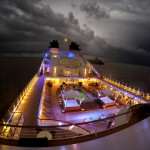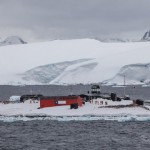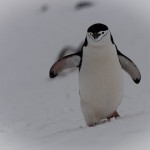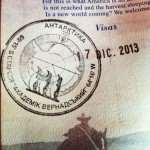
A week ago, as we were leaving Buenos Aires, we were convinced that a fierce storm may have set the tone for our Antarctic adventure (see our video here). Our concern: Crossing the Drake Passage. As any sailor knows, crossing the Drake can be challenging when Mother Nature chooses to not play nice, and we had packed plenty of Dramamine for what we thought might be an “uphill” journey today.
The Dramamine remains untapped, however. It’s 18:06 on a Saturday, and Seabourn Quest is making 18.1 knots across a calm sea. “You’re experiencing Drake Lake,” Expedition Leader Robin West said to an audience during this morning’s mandatory IAATO & Zodiac briefing.
The sea state is classified as 1, calm. There are practically no whitecaps, though we have spotted an iceberg, which Captain Larsen skillfully circumnavigated so that we could get a good look at it (see it in the video shot today below).
In fact, we’re nearly across the Drake. Since yesterday, we have traveled 470 nautical miles from Port Stanley. We have 208 nautical miles to go to reach Half Moon Island in the Antarctic Peninsula region.
Other interesting stats: Sunrise at our current position is at 3:41 a.m. Sunset is at 9:55 p.m. The air temperature is 2.7C (37F). Wind speed is 18 knots from the north. The sea depth is 3,590 meters (nearly 12,000 feet). Happy hour started six minutes (or three sips) ago in the Observation Bar.

So what about all of those videos of damning seas in the Drake Passage? They do occur, but West says that in his experience, seven or eight crossings out of 10 are calm, meaning three-meter to four-meter swells. Another one or two out of ten, and you may have five-meter to six-meter swells, he says. Once in a season most ships will encounter eight-meter swells, he adds.
“The thing with the Drake Passage and the misconception is that people think it is rough all of the time, and that’s not entirely true,” West says. “The problem is that when it gets rough, it can get really rough.”
Last year, during its inaugural season in Antarctica, Seabourn Quest crossed the Drake Passage eight times. All but one of those crossings were on calm seas, with one-meter to two-meter swells. Even during the high seas, however, Quest handled the crossing well. “The ship’s very new,” West says. “We have a state-of-the-art hull and effective stabilizers. We had one crossing last year where we had seven-meter swells, and we slowed down to 12 knots or 13 knots, but after that we pushed on to 15 knots to 16 knots.”
West says size matters when it comes to stability. “I worked for many years on small ships,” he says. “Last year was my first time working on a ship of this size, and it is a completely different experience.” He says Seabourn Quest’s length allows it to “ride across two crests” instead of riding down one swell and up another. “It is a much smoother ride on a larger ship, no doubt about it,” he says.
There are downsides to calm seas. You need 20 knots to 30 knots of wind to see the giant albatrosses. It takes that much wind for a bird with a three-meter wingspan to fly efficiently. “There’s a bit of give and take,” West says. “But if someone coming down to the Drake Passage is worried about the crossing, that’s the last of their worries. The second they see Antarctica they will have forgotten all about the crossing.”
We will step ashore tomorrow morning, with the Drake Passage behind us — for now.



